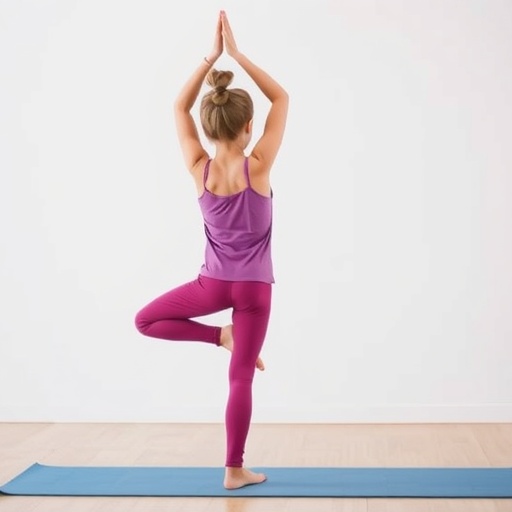In the contemporary landscape of mental health and wellness, new modalities of therapeutic intervention are continually emerging, appealing to both practitioners and patients. One such intervention gaining traction, particularly within the pediatric demographic, is yoga. A systematic review titled “Yoga as a therapeutic intervention for body image in the pediatric population” sheds light on the significant benefits yoga may offer in addressing body image issues among children and adolescents. This comprehensive examination is poised to influence the future of therapeutic approaches, especially considering the alarming rates of body image dissatisfaction prevalent in today’s youth.
Yoga is an ancient practice rooted in physical, mental, and spiritual disciplines. More than just a method for exercise, it offers a holistic framework that encourages self-awareness, mindfulness, and physical health. In the context of pediatric populations, yoga presents a unique opportunity to develop positive body image perceptions and mitigate the psychological distress often associated with body dissatisfaction. Researchers have gathered evidence indicating that regular practice of yoga may foster a more favorable self-image among children and teens.
Body image dissatisfaction has become an increasingly recognized problem that plagues younger generations. This systemic entrenchment has been fueled by pervasive media portrayals, social pressures, and an ever-evolving societal standard regarding physical appearance. Adolescents, particularly, are exposed to these unrealistic ideals that can contribute to negative self-perception. When they turn to social media, they are bombarded by carefully curated images that often distort reality, exacerbating feelings of inadequacy and self-doubt. This creates an urgent need for effective interventions aimed at countering these detrimental influences.
The systematic review by Bullard et al. takes a critical look at the existing literature surrounding the use of yoga as a therapeutic measure. One of the key findings suggests that yoga not only enhances physical health but also serves as a crucible for developing emotional resilience. The practice emphasizes core principles such as acceptance and mindfulness, which can empower individuals to cultivate a more positive relationship with their bodies. Regular engagement with yoga can lead to heightened self-awareness, offering children tools to navigate their body image anxieties more effectively.
Integral to the yoga practice is the mindfulness component, which has been shown to offer significant psychological benefits. By encouraging children to focus on their breath and bodily sensations, mindfulness can foster an environment where they feel safe to explore their feelings, thoughts, and beliefs about their bodies. This safe space is vital, especially in a society where external validation often dictates self-worth. The systematic review highlights that mindfulness meditation, a core aspect of yoga, can lead to reduced levels of anxiety and depression, which are frequently linked with poor body image.
Another prominent theme in the review is the role of yoga in promoting emotional regulation. Children and adolescents often struggle with the ebbs and flows of their emotions, especially in the face of societal pressures about appearance. Yoga acts as a conduit for teaching skills to manage their responses to stressors. By developing a regular yoga practice, young individuals may find themselves better equipped to handle challenges related to body image, ultimately fostering a more balanced emotional state.
Moreover, the physical component of yoga offers additional benefits that may indirectly affect body image perception. As children and adolescents engage in physical postures and develop their strength, flexibility, and coordination, they may begin to appreciate their bodies for what they can achieve rather than how they conform to external expectations. This can shift the focus from appearance to capability, thereby alleviating some of the burdens associated with body image concerns.
Importantly, the review emphasizes the need for further interdisciplinary studies that explore the long-term impacts of yoga practice on body image and self-esteem among pediatric populations. While initial findings are promising, establishing a robust understanding of how yoga influences these aspects over time is crucial. Researchers advocate for more comprehensive studies that employ various methodologies, including qualitative assessments, to capture the nuanced experiences of young practitioners.
The implications of this research extend beyond the immediate benefits to children. As we recognize that fostering a positive body image in youth can lead to improved mental health outcomes, we also see a reduction in the potential for developing eating disorders, anxiety, and depression. Thus, integrating yoga into school curricula, therapy sessions, or community programs could constitute a significant stride towards enhancing the mental well-being of future generations. It is not merely about promoting yoga as a trend; it is about recognizing its potential as a powerful ally in the overarching quest for mental wellness.
As yoga continues to grow in popularity, the healthcare community must consider how to capitalize on its benefits, particularly for vulnerable populations like children. Implementing structured yoga programs in pediatric healthcare settings can provide a supportive platform for young people to explore their bodies and minds in a safe, guided environment. This could lead to a more holistic approach to health that incorporates both physical and mental well-being.
With the increasing pressure from societal expectations, the need to prioritize mental health in children cannot be overstated. As the systematic review by Bullard et al. highlights, yoga represents more than an exercise regime—it is an empowering tool that encourages young individuals to embrace their bodies and cultivate self-love. By championing practices that enhance mental health, we can help create a more resilient generation capable of challenging societal norms and promoting body positivity.
In conclusion, the systematic review presents vital insights into how yoga can serve as an effective therapeutic intervention for body image concerns in the pediatric population. With compelling evidence showcasing its benefits, it paves the way for broader acceptance and integration of yoga within therapeutic frameworks. As we witness the growing recognition of mental health as a critical component of overall well-being, embracing holistic practices like yoga offers hope and healing to those grappling with body image issues.
Subject of Research: Therapy and body image in pediatric populations through yoga interventions.
Article Title: Yoga as a therapeutic intervention for body image in the pediatric population: a systematic review.
Article References:
Bullard, N., Rupani, N., Renteria, J.A. et al. Yoga as a therapeutic intervention for body image in the pediatric population: a systematic review. J Eat Disord 13, 222 (2025). https://doi.org/10.1186/s40337-025-01386-9
Image Credits: AI Generated
DOI: 10.1186/s40337-025-01386-9
Keywords: Yoga, body image, pediatric population, mental health, therapeutic intervention, mindfulness, emotional resilience.
Tags: benefits of yoga for adolescentsbody image issues in childrenholistic approaches to body imageimpact of media on youth body imagemental health and wellness in youthmindfulness practices for kidspromoting positive body image in adolescentspsychological distress and body dissatisfactionself-awareness through yogastrategies to improve self-image in childrentherapeutic interventions for childrenyoga for pediatric body image





